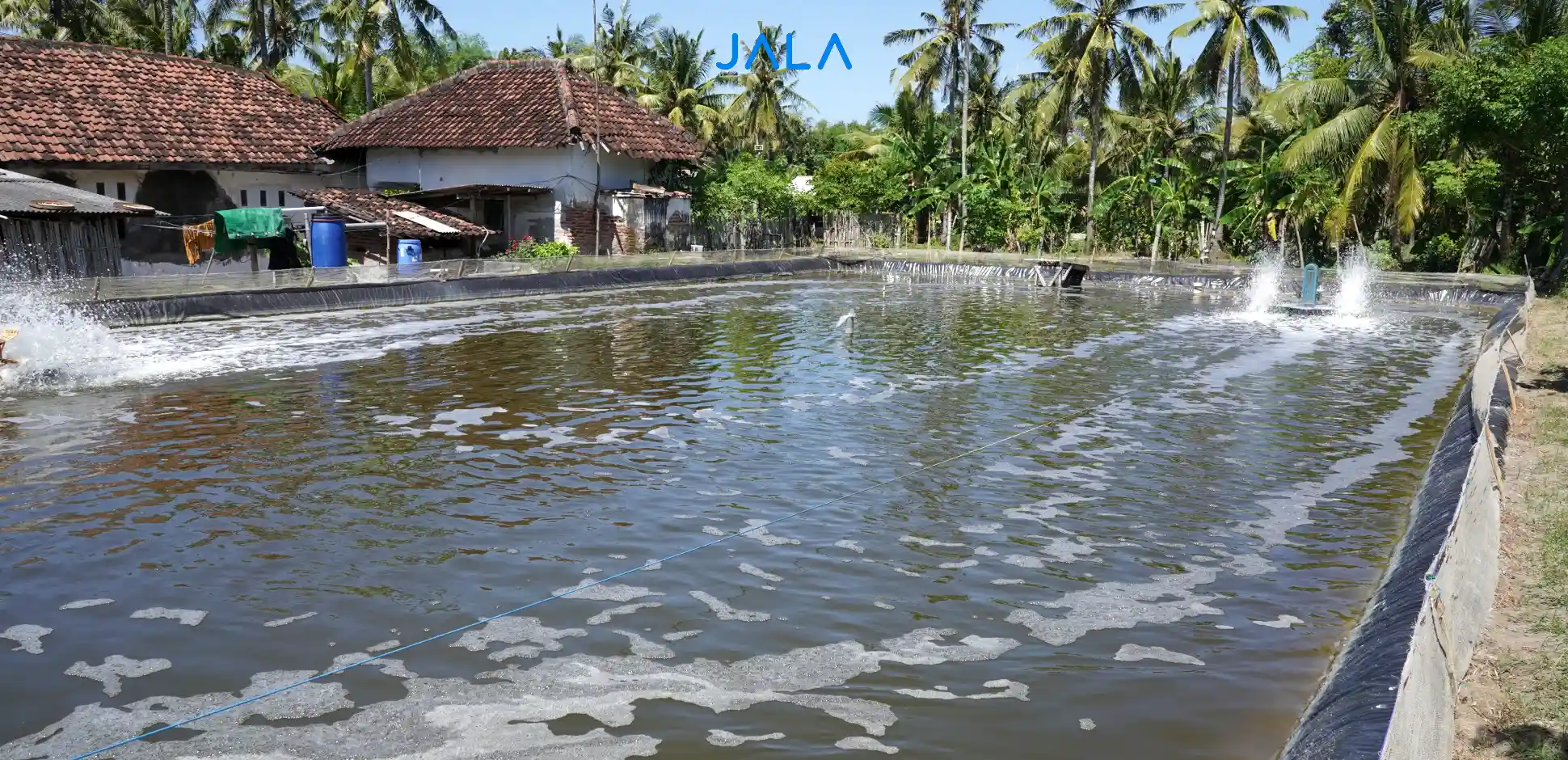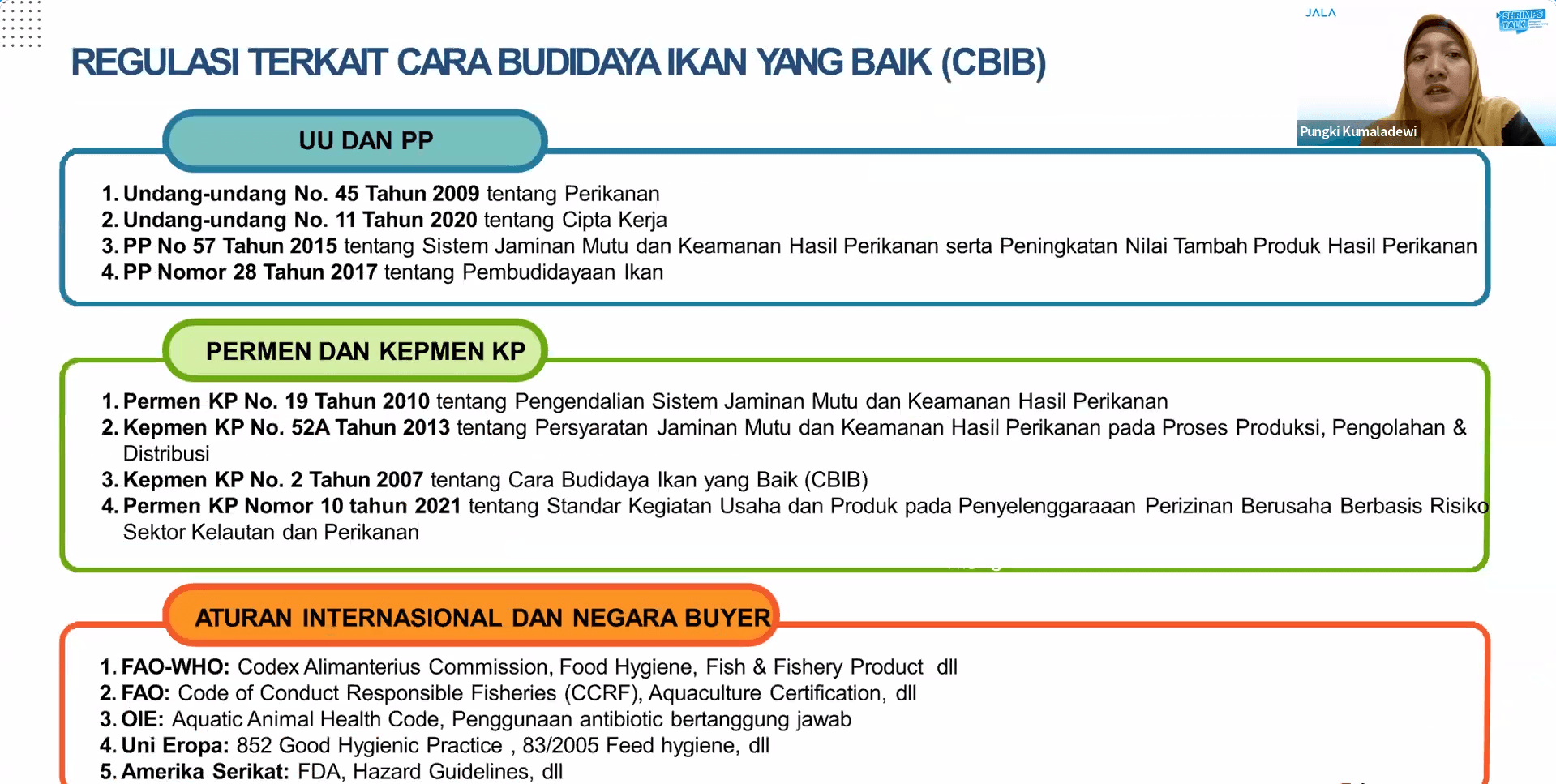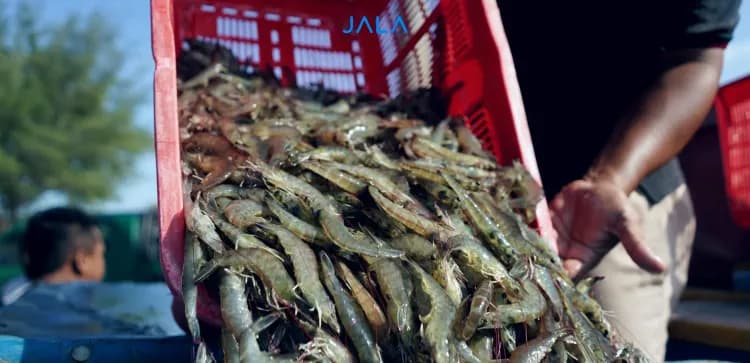
A responsible process that produces safe products is just as important as productivity to the success of shrimp farming. Therefore, the Good Shrimp Cultivation Methods (CBIB) principles should be implemented in this process.
CBIB is a method of cultivating fish and harvesting the results in a controlled environment. This practice will guarantee food and cultivation safety through careful consideration of sanitation, feed, medications, chemicals and biological factors. This principle is not limited to fish commodities only, but also other aquaculture commodities, including shrimp.
Meanwhile, CBIB certification is a series of certificate issuance and control activities through conformity assessments required by CBIB. This certification is issued by the Ministry of Maritime Affairs and Fisheries of Indonesia and covers 4 aspects, namely
- Food safety
- Animal health and welfare
- Environment responsibility
- Socio economic
In cultivation units, traceability and biosecurity are also mandatory.
The fundamental regulations for CBIB implementation
According to the Maritime Affairs and Fisheries Ministerial Regulation No. 10 of 2021, the implementation of CBIB is differentiated based on business scale, namely micro small businesses and medium large businesses.
Micro small businesses
Micro and small businesses are businesses with a medium-low level of risk, and ≤1 billion rupiahs capital for micro businesses and >1-5 billion rupiahs for small businesses. Businesses on this scale are required to have a Business Identification Number (NIB) and Standard Certification (Self Declare).
In its implementation, micro and small businesses are required to implement CBIB principles and require facilities, organizational structure and human resources, process requirements and business management systems, as well as implementing OHSE. These special requirements must be met no later than 1 year after the Self Declare.
Large medium businesses
Medium and large businesses are businesses with a medium-high level of risk and >5-10 billion rupiahs capital for medium businesses and >10 billion rupiahs for large businesses. Businesses of this scale are required to have a Business Identification Number and verified Standard Certificate.
Medium and large businesses are required to have a CBIB certificate and require facilities, organizational structure and human resources, process requirements, and a business management system, have production process standards, and implement OSHE. These requirements must be met no later than 1 year after running business according to the enlargement cycle.

What must farmers prepare to apply for CBIB?
Submission and verification of CBIB implementation for both micro small and medium large businesses require main and supporting requirements. The main requirements must be met before running commercial business activities, while the supporting requirements need to be met according to certain conditions and time.
Main Requirements for Micro Small Businesses
The main requirements for micro small businesses are divided into basic requirements and risk-based business licensing. The following two basic requirements must be met:
- Suitability of Space Utilization Activities (KKPR) for Land, for micro businesses it may take form of an Independent Statement
- Environmental Approval, for micro businesses with land area <10 Ha it may take form of an Independent Statement
The following risk-based business permits must also be met:
- Business Identification Number
- Standard Certificate through independent statement
Supporting Requirements for Micro Small Businesses
These supporting requirements take the form of Business Licensing to Support Business Activities (PB UMKU). CBIB implementation is implemented no later than 1 year after self declare. However, micro small business units do not require certification as they only receive coaching.
Main Requirements for Medium Large Businesses
Similar to the main requirements for micro small units, the main requirements for medium large units also consist of basic requirements and risk-based business licensing. The following are the basic requirements for a medium large unit:
- KKPR for Land and KKPR for Marine, for business actors who utilize marine space
- Environmental Approval
The following are risk-based business licensing required:
- Business Identification Number
- Verified Standard Certificate
Supporting Requirements for Medium Large Businesses
These supporting requirements also take the form of PB UMKU. Medium large units are set to apply for CBIB certification no later than 1 year after starting business.
CBIB applications are made through the One Single Submission (OSS) app. For further information, please contact the local Fisheries and Maritime Service.
Why is CBIB certification needed for shrimp farming?
CBIB is a guarantee for responsible shrimp farming. There are four reasons why this certification is important and should be owned or implemented.
Quality assurance
CBIB certification will ensure product quality assurance. CBIB will be a proof that the cultivation activities run have implemented good cultivation principles.
Consumer demands
Consumers today are very selective regarding food safety issues. Not only do they concern about the origin of the products they consume, they also want the products to be safe in the short and long term. With CBIB, the product has the potential to meet consumer expectations and demands.
Export requirements
CBIB has become an export requirement in fish processing units. Export destination countries also require cultivation product certificates for products shipped to their country. One of the certifications required is CBIB certification.
Increase competitiveness
With CBIB certification, cultivation products have higher competitiveness compared to products that are not certified.
CBIB Criteria
In the audit conducted by the provincial Fisheries and Maritime Service, there are several criteria that need to be met by business owners or farmers, including:
Cultivation location
The location must comply with the regional spatial management plan, have sufficient water availability, proper water quality, no potential for contamination, comply with environmental sustainability, and is free of conflict.
Design and layout
Farm design needs to be optimal, have low risk of contamination, environmentally friendly, and have sanitation installed.
Equipment
Cultivation equipment is made from environmentally friendly materials, safe to use, divided into different containers, and is easy to clean.
Farm plot
The construction of the farm is made with the low risk of contamination, well prepared, disinfected, and labeled according to its designation.
Shrimp fry
Shrimp fry must be provided from a CPIB-certified hatchery, supported by PCR testing, and stocked using a proper method according to the stocking density.
Feed
Farmers must pay attention to the feed registration number and expiration date. The feed must also be stored in a distinctive container or room.
Cleanliness of the location and its facilities
Farm hygiene must be maintained, waste and hazardous materials need to be disposed of properly, and farm equipment must be clean.
Health management
Shrimp health is monitored regularly, biosecurity is implemented effectively, source water quality needs to be monitored, and waste must be processed properly before disposal.
Cultivation water
Try to avoid salination as much as possible when using source water. Additionally, efficient management and routine testing of water quality are required.
Waste management
Solid, liquid, as well as hazardous and toxic waste need to be managed effectively so as not to damage the environment.
Environmental management
The quality of the cultivation environment needs to be managed properly, electrical energy and fuel are used efficiently, wild animal control is conducted in an environmentally friendly manner, and environmental restoration around the cultivation unit as well as collective management must also be conducted.
Harvest and post-harvest
The process must be conducted quickly, the water and ice used to keep the shrimp are kept clean, the equipment must be ensured to not contaminate shrimp, and shrimp must go through a cold chain system.
Farm personnel and their competency
Workers’ welfare must be ensured, OHSE aspects need to be addressed, avoid underage children employment, and there should be training for farm personnel.
Documentation
Record cultivation process since the preparation period to post-harvest, including shrimp sampling and water quality recording.
Find other noteworthy insights with JALA
The CBIB discussion above was delivered by Pungky Kumaladewi, S.Pi., M.Si. from the East Java Province Fisheries and Maritime Service when she became a speaker at the 14th SHRIMPS TALK webinar. This webinar was held to provide shrimp farmers with an understanding of CBIB and its importance for cultivation.
In addition to Pungky, the 14th SHRIMPS TALK also featured another speaker who discussed the latest challenges of the shrimp industry and their solutions. Stay tuned for updates on JALA’s blog!





